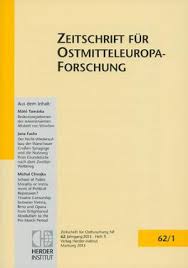Zwischen Westen und Osten. Der schlesische Ständeparlamentarismus von seinen Anfängen bis in das 19. Jahrhundert
Between East and West. The Silesian Estates’ Parliamentary System from its Beginnings down to the 19th Century
Author(s): Marian J. PtakSubject(s): Law, Constitution, Jurisprudence, Political history, Middle Ages, 19th Century
Published by: Verlag Herder-Institut
Keywords: East and West; Silesian Estates’ Parliamentary System; 19th Century;
Summary/Abstract: The Silesian parliamentarism of estates can be seen in Silesia as a whole, in the individual dukedoms and in the municipal areas. Its beginning was the colloquium, a congress of dukes and their subjects. In the 14th century, the colloquium developed into a pan-Silesian meeting between piast dukes, the diet of princes (Fürstentag). In 1430’s, the constitution of the Fürstentag was changed. It was no longer an exclusive assembly of piaster dukes, but, in addition, included Silesian dukes and sovereigns of different dynasties. Later, representatives of the nobility, of the towns and of the clergy also took part in the Fürstentag, whose competencies were legislation, justice and administration. On other hand, the provincial diet (Landtag) was a congregation of the respective sovereigns and of the free magnates. Only landowners of knightly law were allowed to participate. Besides the nobility, churchmen, towns and other freemen were among the assembled. On a local level, one finds the municipal corporations as a third element in the Silesian parliamentarism of the estates. The most prominent examples of these corporations were the county councils (Weichbildtage, Kreistage). Mandate and vote were intially restricted to noble landowners; later, monasteries and towns are admitted as property owners in knightly law. Council commissions had legislative, executive (police) and military duties. The system was brought to an end with the conquest of the greater part of Silesia by the King of Prussia, who dissolved all estates’ assemblies at the central and the dukedom level. Only at the local level did the councils survive. The formation of the Silesian Territory represented an experiment to establish a corporation on a national level. Its competences were limited to grant loans. Another revival of the Silesian estates’ parliamentarism was the convocation of the Silesian State Parliament and the county councils by the monarch in 1824. The structure of the State Parliament was similar to that of the Fürstentag. Its competencies were consultation and assistance to the executive on the implementation of the monarchical enactments. With the county constitution (Kreisordnung) enacted in 1872, and the province constitution (Provinzialordnung) enacted in 1875, this parliamentarism of the estates came to an end, as the designated Landtag and Kreistag were no longer corporations by class, but by territorial self-administration in the constitutional monarchy. In the Austrian part of Silesia the county councils were dissolved, whereas the state parliament and Fürstentag were rearranged as a result of the convocation of the Enlarged Silesian public convention consisting of 48 landowners and burghers. These representatives elected the 13 commissioners of the Greater commission of the enlarged Silesian public convention.
Journal: Zeitschrift für Ostmitteleuropa-Forschung
- Issue Year: 58/2009
- Issue No: 3
- Page Range: 300-311
- Page Count: 12
- Language: German

